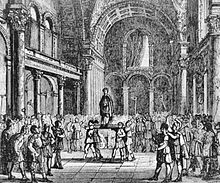- Thermes de Cluny
-
Model of Thermes de Cluny showing the major elements of the baths. In the center of the picture is the frigidarium; to the left of the frigidarium is the tepidarium; to the fore of the tepidarium is the caldarium. S. Michel bd forms the left boundary of the picture, S. Germain bd forms the top boundary. Photo: Wiki user Maryas

Thermes de Cluny are an ancient Gallo-Roman ruin lying in the heart of Paris' 5th arrondissement and which are partly subsumed into the Musée de Moyen Age-Hôtel de Cluny.
The present bath ruins constitute about one-third of a massive bath complex that is believed to have been constructed around the beginning of the 3rd century. The best preserved room is the frigidarium with intact architectural elements such as Gallo-Roman vaults, ribs and consoles and fragments of original decorative wall painting and mosaics.
 Thermes de Cluny: caldarium
Thermes de Cluny: caldarium
It is believed that the bath complex was built by the influential guild of boatmen of 3rd century Roman Paris or Lutetia, as evidenced by the fact that the consoles on which the barrel ribs rest are carved in the shape of ships' prows. Like all Roman Baths, these baths were freely open to the public, and were meant to be, at least partially, a means of romanizing the ancient Gauls. [1] As the baths lay across the Seine river on the left bank and were unprotected by defensive fortifications, they were easy prey to roving barbarian groups who apparently destroyed the bath complex sometime at the end of the 3rd century.
The bath complex is now partly an archeological site and partly incorporated into the Musée du Moyen Age, and as such is the occasional repository for historic stonework or masonry found from time to time in Paris. The spectacular frigidarium is entirely incorporated within the museum and houses the Pilier des Nautes. Although somewhat obscured by renovations and reuse over the past two thousand years, several other rooms from the bath complex are also incorporated into the museum, notably the gymnasium which now forms part of gallery 9 (Galley of French Kings and sculptures from Notre Dame). The caldarium (hot water room) and the tepidarium (warm water room) are both still present as ruins outside the Musée itself and on the museum's grounds.
Sources
- Album de Musee' national du Moyen Age Thermes de Cluny, Pierre-Yves Le Pogam, Dany Sandron (ISBN 2-7118-2777-1)
- Architect’s Guide to Paris, Renzo Salvadori, (ISBN 0-408-50068-9) London, 1990.
- Caesar to Charlemagne: The beginning of France, Robert Latouche, (ISBN 0-460-07728-7) 1968.
- Round and about Paris, Vol. 1, Thirza Vallois (ISBN 0-9525378-0-X), 1995.
External links
Categories:- 3rd-century architecture
- Roman Gaul
- Archaeological sites in France
- Ancient Roman architecture
- Buildings and structures in Paris
- Roman Paris
- Ruins in France
Wikimedia Foundation. 2010.


